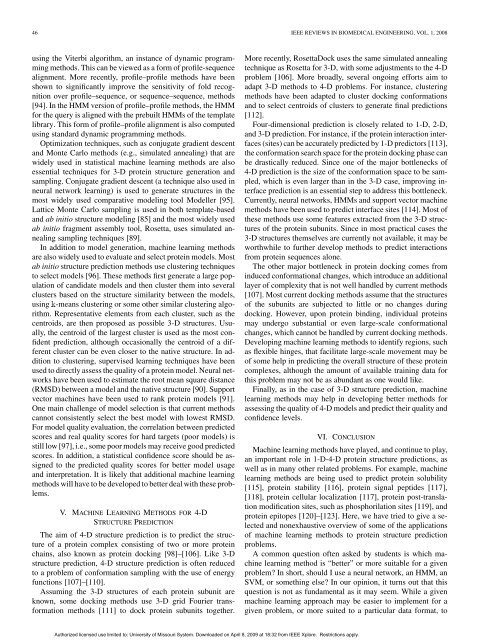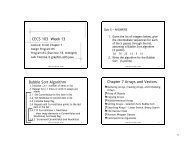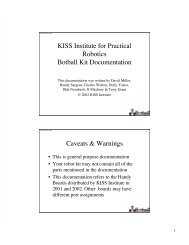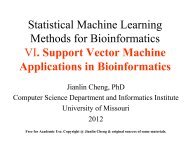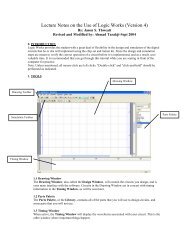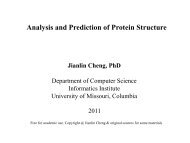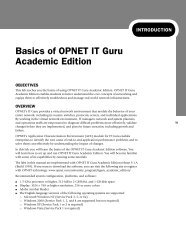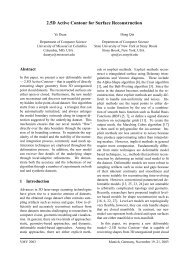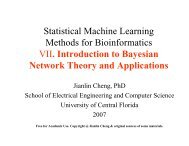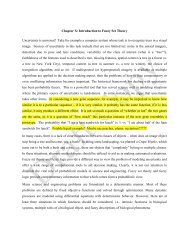46 IEEE REVIEWS IN BIOMEDICAL ENGINEERING, VOL. 1, 2008 using the Viterbi algorithm, an instance of dynamic programming methods. This can be viewed as a <strong>for</strong>m of profile-sequence alignment. More recently, profile–profile methods have been shown to significantly improve the sensitivity of fold recognition over profile–sequence, or sequence–sequence, methods [94]. In the HMM version of profile–profile methods, the HMM <strong>for</strong> the query is aligned with the prebuilt HMMs of the template library. This <strong>for</strong>m of profile–profile alignment is also computed using standard dynamic programming methods. Optimization techniques, such as conjugate gradient descent and Monte Carlo methods (e.g., simulated annealing) that are widely used in statistical machine learning methods are also essential techniques <strong>for</strong> 3-D protein structure generation and sampling. Conjugate gradient descent (a technique also used in neural network learning) is used to generate structures in the most widely used comparative modeling tool Modeller [95]. Lattice Monte Carlo sampling is used in both template-based and ab initio structure modeling [85] and the most widely used ab initio fragment assembly tool, Rosetta, uses simulated annealing sampling techniques [89]. In addition to model generation, machine learning methods are also widely used to evaluate and select protein models. Most ab initio structure prediction methods use clustering techniques to select models [96]. These methods first generate a large population of candidate models and then cluster them into several clusters based on the structure similarity between the models, using -means clustering or some other similar clustering algorithm. Representative elements from each cluster, such as the centroids, are then proposed as possible 3-D structures. Usually, the centroid of the largest cluster is used as the most confident prediction, although occasionally the centroid of a different cluster can be even closer to the native structure. In addition to clustering, supervised learning techniques have been used to directly assess the quality of a protein model. Neural networks have been used to estimate the root mean square distance (RMSD) between a model and the native structure [90]. Support vector machines have been used to rank protein models [91]. One main challenge of model selection is that current methods cannot consistently select the best model with lowest RMSD. For model quality evaluation, the correlation between predicted scores and real quality scores <strong>for</strong> hard targets (poor models) is still low [97], i.e., some poor models may receive good predicted scores. In addition, a statistical confidence score should be assigned to the predicted quality scores <strong>for</strong> better model usage and interpretation. It is likely that additional machine learning methods will have to be developed to better deal with these problems. V. MACHINE LEARNING METHODS FOR 4-D STRUCTURE PREDICTION The aim of 4-D structure prediction is to predict the structure of a protein complex consisting of two or more protein chains, also known as protein docking [98]–[106]. Like 3-D structure prediction, 4-D structure prediction is often reduced to a problem of con<strong>for</strong>mation sampling with the use of energy functions [107]–[110]. Assuming the 3-D structures of each protein subunit are known, some docking methods use 3-D grid Fourier trans<strong>for</strong>mation methods [111] to dock protein subunits together. More recently, RosettaDock uses the same simulated annealing technique as Rosetta <strong>for</strong> 3-D, with some adjustments to the 4-D problem [106]. More broadly, several ongoing ef<strong>for</strong>ts aim to adapt 3-D methods to 4-D problems. For instance, clustering methods have been adapted to cluster docking con<strong>for</strong>mations and to select centroids of clusters to generate final predictions [112]. Four-dimensional prediction is closely related to 1-D, 2-D, and 3-D prediction. For instance, if the protein interaction interfaces (sites) can be accurately predicted by 1-D predictors [113], the con<strong>for</strong>mation search space <strong>for</strong> the protein docking phase can be drastically reduced. Since one of the major bottlenecks of 4-D prediction is the size of the con<strong>for</strong>mation space to be sampled, which is even larger than in the 3-D case, improving interface prediction is an essential step to address this bottleneck. Currently, neural networks, HMMs and support vector machine methods have been used to predict interface sites [114]. Most of these methods use some features extracted from the 3-D structures of the protein subunits. Since in most practical cases the 3-D structures themselves are currently not available, it may be worthwhile to further develop methods to predict interactions from protein sequences alone. The other major bottleneck in protein docking comes from induced con<strong>for</strong>mational changes, which introduce an additional layer of complexity that is not well handled by current methods [107]. Most current docking methods assume that the structures of the subunits are subjected to little or no changes during docking. However, upon protein binding, individual proteins may undergo substantial or even large-scale con<strong>for</strong>mational changes, which cannot be handled by current docking methods. Developing machine learning methods to identify regions, such as flexible hinges, that facilitate large-scale movement may be of some help in predicting the overall structure of these protein complexes, although the amount of available training data <strong>for</strong> this problem may not be as abundant as one would like. Finally, as in the case of 3-D structure prediction, machine learning methods may help in developing better methods <strong>for</strong> assessing the quality of 4-D models and predict their quality and confidence levels. VI. CONCLUSION <strong>Machine</strong> learning methods have played, and continue to play, an important role in 1-D-4-D protein structure predictions, as well as in many other related problems. For example, machine learning methods are being used to predict protein solubility [115], protein stability [116], protein signal peptides [117], [118], protein cellular localization [117], protein post-translation modification sites, such as phosphorilation sites [119], and protein epitopes [120]–[123]. Here, we have tried to give a selected and nonexhaustive overview of some of the applications of machine learning methods to protein structure prediction problems. A common question often asked by students is which machine learning method is “better” or more suitable <strong>for</strong> a given problem? In short, should I use a neural network, an HMM, an SVM, or something else? In our opinion, it turns out that this question is not as fundamental as it may seem. While a given machine learning approach may be easier to implement <strong>for</strong> a given problem, or more suited to a particular data <strong>for</strong>mat, to Authorized licensed use limited to: University of Missouri System. Downloaded on April 8, 2009 at 18:32 from IEEE Xplore. Restrictions apply.
CHENG et al.: MACHINE LEARNING METHODS FOR PROTEIN STRUCTURE PREDICTION 47 tackle difficult problems what matters in the end is the expertise a scientist has in a particular machine learning technology. What can be obtained with a general-purpose machine learning method can be achieved using another general-purpose machine learning method, provided the learning architecture and algorithms are properly crafted. In the <strong>for</strong>eseeable future, machine learning methods will continue to play a role in protein structure prediction and its multiple facets. The growth in the size of the available training sets coupled with the gap between the number of sequences and the number of solved structures remain powerful motivators <strong>for</strong> further developments. Furthermore, in many cases machine learning methods are relatively fast compared to other methods. <strong>Machine</strong> learning methods spend most of their time in the learning phase, which can be done offline. In “production” mode, a pretrained feed<strong>for</strong>ward neural network, <strong>for</strong> instance, can produce predictions rather fast. Both accuracy and speed considerations are likely to remain important as genomic, proteomic, and protein engineering projects continue to generate great challenges and opportunities in this area. REFERENCES [1] F. Sanger and E. O. Thompson, “The amino-acid sequence in the glycyl chain of insulin.1. The identification of lower peptides from partial hydrolysates,” J. Biochem., vol. 53, no. 3, pp. 353–366, 1953a. [2] F. Sanger and E. O. Thompson, “The amino-acid sequence in the glycyl chain of insulin. II. The investigation of peptides from enzymic hydrolysates,” J. Biochem., vol. 53, no. 3, pp. 366–374, 1953b. [3] L. Pauling and R. B. Corey, “The pleated sheet, a new layer configuration of the polypeptide chain,” Proc. Nat. Acad. Sci., vol. 37, pp. 251–256, 1951. [4] L. Pauling, R. B. Corey, and H. R. Branson, “The structure of proteins: Two hydrogenbonded helical configurations of the polypeptide chain,” Proc. Nat. Acad. Sci., vol. 37, pp. 205–211, 1951. [5] J. C. Kendrew, R. E. Dickerson, B. E. Strandberg, R. J. Hart, D. R. Davies, D. C. Phillips, and V. C. Shore, “<strong>Structure</strong> of myoglobin: A three-dimensional Fourier synthesis at 2_a resolution,” Nature, vol. 185, pp. 422–427, 1960. [6] M. F. Perutz, M. G. Rossmann, A. F. Cullis, G. Muirhead, G. Will, and A. T. North, “<strong>Structure</strong> of haemoglobin: A three-dimensional Fourier synthesis at 5.5 Angstrom resolution, obtained by x-ray analysis,” Nature, vol. 185, pp. 416–422, 1960. [7] K. A. Dill, “Dominant <strong>for</strong>ces in protein folding,” Biochemistry, vol. 31, pp. 7134–7155, 1990. [8] R. A. Laskowski, J. D. Watson, and J. M. Thornton, “From protein structure to biochemical function?,” J. Struct. Funct. Genomics, vol. 4, pp. 167–177, 2003. [9] A. Travers, “DNA con<strong>for</strong>mation and protein binding,” Ann. Rev. Biochem., vol. 58, pp. 427–452, 1989. [10] P. J. Bjorkman and P. Parham, “<strong>Structure</strong>, function and diversity of class I major histocompatibility complex molecules,” Ann. Rev. Biochem., vol. 59, pp. 253–288, 1990. [11] L. Bragg, The Development of X-Ray Analysis. London, U.K.: G. Bell, 1975. [12] T. L. Blundell and L. H. Johnson, <strong>Protein</strong> Crystallography. New York: Academic, 1976. [13] K. Wuthrich, NMR of <strong>Protein</strong>s and Nucleic Acids. New York: Wiley, 1986. [14] E. N. Baldwin, I. T. Weber, R. S. Charles, J. Xuan, E. Appella, M. Yamada, K. Matsushima, B. F. P. Edwards, G. M. Clore, A. M. Gronenborn, and A. Wlodawar, “Crystal structure of interleukin 8: Symbiosis of NMR and crystallography,” Proc. Nat. Acad. Sci., vol. 88, pp. 502–506, 1991. [15] H. M. Berman, J. Westbrook, Z. Feng, G. Gilliland, T. N. Bhat, H. Weissig, I. N. Shindyalov, and P. E. Bourne, “The protein data bank,” Nucl. Acids Res., vol. 28, pp. 235–242, 2000. [16] J. M. Chandonia and S. E. Brenner, “The impact of structural genomics: Expectations and outcomes,” Science, vol. 311, pp. 347–351, 2006. [17] C. B. Anfinsen, “Principles that govern the folding of protein chains,” Science, vol. 181, pp. 223–230, 1973. [18] D. Petrey and B. Honig, “<strong>Protein</strong> structure prediction: Inroads to biology,” Mol. Cell., vol. 20, pp. 811–819, 2005. [19] M. Jacobson and A. Sali, “Comparative protein structure modeling and its applications to drug discovery,” in Annual Reports in Medical Chemistry, J. Overington, Ed. London, U.K.: Academic, 2004, pp. 259–276. [20] B. Rost, J. Liu, D. Przybylski, R. Nair, K. O. Wrzeszczynski, H. Bigelow, and Y. Ofran, “Prediction of protein structure through evolution,” in Handbook of Chemoin<strong>for</strong>matics – From Data to Knowledge, J. Gasteiger and T. Engel, Eds. New York: Wiley, 2003, pp. 1789–1811. [21] P. Baldi and S. Brunak, Bioin<strong>for</strong>matics: The <strong>Machine</strong> <strong>Learning</strong> Approach, 2nd ed. Cambridge, MA: MIT Press, 2001. [22] B. Rost and C. Sander, “Improved prediction of protein secondary structure by use of sequence profiles and neural networks,” Proc. Nat. Acad. Sci., vol. 90, no. 16, pp. 7558–7562, 1993a. [23] B. Rost and C. Sander, “Prediction of protein secondary structure at better than 70% accuracy,” J. Mol. Bio., vol. 232, no. 2, pp. 584–599, 1993b. [24] D. T. Jones, “<strong>Protein</strong> secondary structure prediction based on positionspecific scoring matrices,” J. Mol. Bio., vol. 292, pp. 195–202, 1999b. [25] G. Pollastri, D. Przybylski, B. Rost, and P. Baldi, “Improving the prediction of protein secondary structure in three and eight classes using recurrent neural networks and profiles,” <strong>Protein</strong>s, vol. 47, pp. 228–235, 2002a. [26] B. Rost and C. Sander, “Conservation and prediction of solvent accessibility in protein families,” <strong>Protein</strong>s, vol. 20, no. 3, pp. 216–226, 1994. [27] G. Pollastri, P. Baldi, P. Fariselli, and R. Casadio, “Prediction of coordination number and relative solvent accessibility in proteins,” <strong>Protein</strong>s, vol. 47, pp. 142–153, 2002b. [28] P. Fariselli, O. Olmea, A. Valencia, and R. Casadio, “Prediction of contact maps with neural networks and correlated mutations,” Prot. Eng., vol. 13, pp. 835–843, 2001. [29] G. Pollastri and P. Baldi, “Prediction of contact maps by GIOHMMs and recurrent neural networks using lateral propagation from all four cardinal corners,” Bioinfo., vol. 18, no. Suppl 1, pp. S62–S70, 2002. [30] P. Fariselli and R. Casadio, “Prediction of disulfide connectivity in proteins,” Bioinfo., vol. 17, pp. 957–964, 2004. [31] A. Vullo and P. Frasconi, “A recursive connectionist approach <strong>for</strong> predicting disulfide connectivity in proteins,” in Proc. 18th Annu. ACM Symp. Applied Computing, 2003, pp. 67–71. [32] P. Baldi, J. Cheng, and A. Vullo, “Large-scale prediction of disulphide bond connectivity,” in Advances in Neural In<strong>for</strong>mation Processing Systems, L. Bottou, L. Saul, and Y. Weiss, Eds. Cambridge, MA: MIT Press, 2005, vol. 17, NIPS04 Conf., pp. 97–104. [33] J. Cheng, H. Saigo, and P. Baldi, “Large-scale prediction of disulphide bridges using kernel methods, two-dimensional recursive neural networks, and weighted graph matching,” <strong>Protein</strong>s: <strong>Structure</strong>, Function, Bioin<strong>for</strong>matics, vol. 62, no. 3, pp. 617–629, 2006b. [34] J. Moult, K. Fidelis, A. Kryshtafovych, B. Rost, T. Hubbard, and A. Tramontano, “Critical assessment of methods of protein structure prediction-Round VII,” <strong>Protein</strong>s, vol. 29, pp. 179–187, 2007. [35] S. J. Wodak, “From the Mediterranean coast to the shores of Lake Ontario: CAPRI’s premiere on the American continent,” <strong>Protein</strong>s, vol. 69, pp. 687–698, 2007. [36] P. Baldi, Y. Chauvin, T. Hunkapillar, and M. McClure, “Hidden Markov models of biological primary sequence in<strong>for</strong>mation,” Proc. Nat. Acad. Sci., vol. 91, no. 3, pp. 1059–1063, 1994. [37] A. Krogh, M. Brown, I. S. Mian, K. Sjolander, and D. Haussler, “Hidden Markov models in computational biology: Applications to protein modeling,” J. Mol. Biol., vol. 235, pp. 1501–1531, 1994. [38] D. E. Rumelhart, G. E. Hinton, and R. J. Williams, “<strong>Learning</strong> representations by back-propagating error,” Nature, vol. 323, pp. 533–536, 1986. [39] V. Vapnik, The Nature of Statistical <strong>Learning</strong> Theory. Berlin, Germany: Springer-Verlag, 1995. [40] K. Bryson, D. Cozzetto, and D. T. Jones, “Computer-assisted protein domain boundary prediction using the DomPred server,” Curr <strong>Protein</strong> Pept Sci., vol. 8, pp. 181–188, 2007. [41] M. Tress, J. Cheng, P. Baldi, K. Joo, J. Lee, J. H. Seo, J. Lee, D. Baker, D. Chivian, D. Kim, A. Valencia, and I. Ezkurdia, “Assessment of predictions submitted <strong>for</strong> the CASP7 domain prediction category,” <strong>Protein</strong>s: <strong>Structure</strong>, Function and Bioin<strong>for</strong>matics, vol. 68, no. S8, pp. 137–151, 2007. [42] J. Cheng, “DOMAC: An accurate, hybrid protein domain prediction server,” Nucleic Acids Res., vol. 35, pp. w354–w356, 2007. [43] Z. Obradovic, K. Peng, S. Vucetic, P. Radivojac, and A. K. Dunker, “Exploiting heterogeneous sequence properties improves prediction of protein disorder,” <strong>Protein</strong>s, vol. 61, no. Suppl 1, pp. 176–182, 2005. [44] J. J. Ward, L. J. McGuffin, K. Bryson, B. F. Buxton, and D. T. Jones, “The DISOPRED server <strong>for</strong> the prediction of protein disorder,” Bioinfo., vol. 20, pp. 2138–2139, 2004. [45] J. Cheng, M. J. Sweredoski, and P. Baldi, “Accurate prediction of protein disordered regions by mining protein structure data,” Data Mining Knowledge Discovery, vol. 11, pp. 213–222, 2005. Authorized licensed use limited to: University of Missouri System. Downloaded on April 8, 2009 at 18:32 from IEEE Xplore. Restrictions apply.


